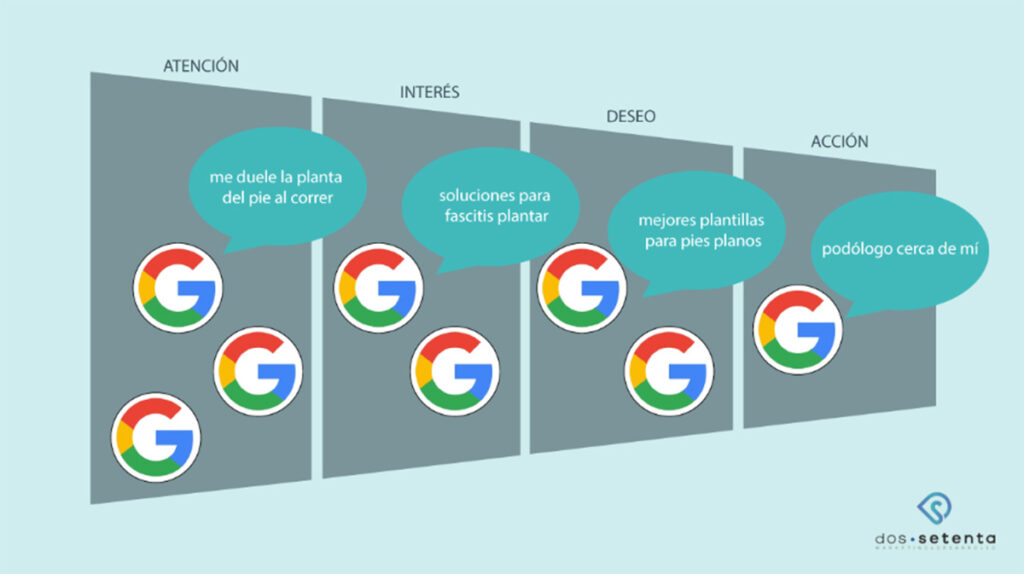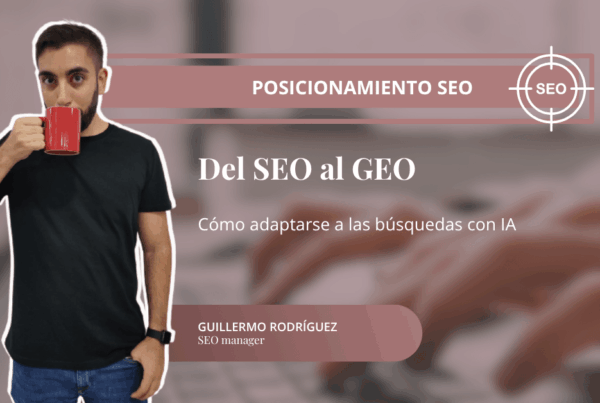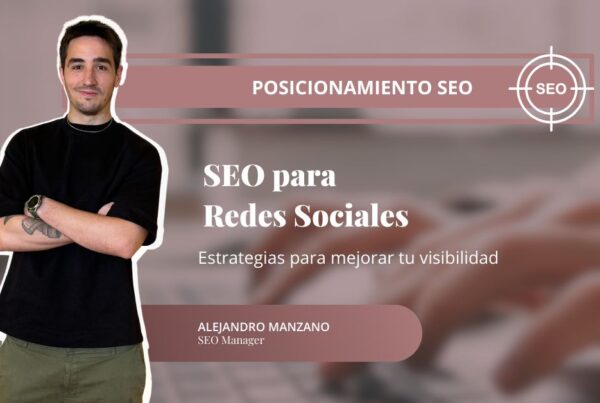There are a thousand ways to create a SEO content strategy, but only a few that truly help you achieve your business goals. To get different results, we must be willing to do things differently.
[poll id=”2″]In this article, we’ll show you the best way to apply a content strategy for your blog. With it, you’ll learn how to identify the information your customers are demanding from your brand and how to give them what they’re really interested in.
What is an SEO Content Strategy for Your Blog?
To fully understand this concept, let’s simplify its parts to better understand the whole. If you’re interested in learning SEO at a strategic level, I assume you already know the basic concepts of SEO. But it never hurts to review the fundamentals.
SEO content is the information we offer on our websites that is also optimized to rank in the top positions of search engines like Google.
You already know everything that goes into optimizing content: defining a focus keyword, maintaining its density within the text, using related keywords, crafting meta descriptions… and all those actions we perform for on-page SEO.
By definition, strategy is a plan of actions that guides us toward a goal or objective. Therefore, an SEO content strategy is a plan that allows us to determine the type of content we need to publish on our website to reach our desired goals.
Easy, right?
Weeell, strategy requires planning and organization — in other words, time and effort. That’s why it’s important to understand why creating a strategic content plan is worth it.
Why Is It Worth the Effort to Create an SEO Content Strategy?
Let’s be honest: an SEO content plan takes work. If we’re not clear on why the effort is worth it, we won’t dedicate the time and care it deserves.
Reason No. 1: Your Customer Doesn’t Care About You

For your customer to consider you, you first have to show that you care about them.
Yes, you heard that right. People are naturally selfish. You are, and so am I. It’s not a bad thing, but for those of us in marketing, it’s something we must never forget. What matters most to our customers are their problems and desires. And they won’t pay attention to what we want to offer unless it’s something that truly interests them.
You wouldn’t read this article just because I tell you it took me a lot of effort to write. You’ll keep reading only if you find it relevant and helpful for your SEO content strategy — which is why you’re here. If you’re still reading, I’m glad you find it valuable.
Developing an SEO content strategy allows us to identify the type of information that matters to our clients and what they need to hear. This helps us focus on writing content that truly generates business, rather than creating meaningless blog posts that don’t contribute anything.
How do we achieve this?
- By creating content that’s interesting to the user.
- It must be useful in solving their problems or helping them get what they want.
- And finally, it must be entertaining.
Reason No. 2: We’ll Better Adapt Our Content to Our Customer’s Level of Awareness
What is the customer’s level of awareness? Basically, it’s the amount of knowledge and education that our potential clients have about our product or service — and where they are in the sales funnel and customer journey.
For example, in my case, when writing this article, I’m assuming you already have some background in marketing and SEO. Because if you’re interested in learning about SEO content strategy, you must at least understand the basics.
That’s why I have no problem using industry terminology — I know you’ll follow along. But if you were searching for “What is SEO?” on Google, I’d need to explain everything at a much more basic level.
Although this may seem obvious, we often forget to apply it. We get so caught up in writing an article targeting an informational or transactional keyword that we forget about the bigger picture — especially the user’s search intent.
Reason No. 3: It Brings Many Benefits
- It’s the foundation for being consistent with your content production.
- It helps you create balanced content. Thanks to planning, you’ll end up targeting a large number of informational, navigational, transactional, and commercial keywords — making your website richer.
- It makes task distribution easier when working in a team. And if you’re your own team, it helps you manage your time and workload better.
- And above all, it saves you time, effort, and money.
Now that you understand why it’s worth creating a content strategy, we’re ready to talk about how to put it into action.
Let’s get started.
How to Create an SEO Content Strategy
Marketing stopped being product-centered long ago and became customer-centered. The famous quote by Henry Ford would now be unthinkable:
“A customer can have a car painted any color they want, as long as it’s black.”
Henry Ford
With digital transformation and the growing influence of social media, more than ever, the user must be at the center of every decision. That’s why the first step in our content strategy should be:
Step 1: Know Your Customer
Yes, you’ve probably heard this a thousand times before — but it’s so important that it’s worth repeating.
RESEARCH AND UNDERSTAND YOUR CUSTOMER
And it’s not enough to know their objective information — like where they live, their age, gender, or income level. Honestly, that’s no longer sufficient. We need to go deeper and understand their motivations, emotions, and interests.
Why is this subjective information so important?
Because it’s what allows us to connect with our audience on an emotional level. And it ensures that our SEO content strategy — and all our business actions — are aligned with the real needs of our customers.
For example, knowing this at Dos Setenta allows us to understand the interests and concerns of the ideal client we want to work with. That’s why it makes sense for us to tell you about our CEO, Álvaro Peña, and the content he shares on LinkedIn.
We sometimes forget that our customers are more than just numbers in Search Console or Google Analytics. Behind those numbers are people with feelings and concerns. Connecting with their emotions — beyond providing good service or having a great product — makes the difference in building long-term, quality relationships with them.
Step 2: Define and Be Clear About Your Goal
“No wind is favorable to the ship that has no destination.”
Seneca
If we’re not clear about what we want to achieve, no matter how much we plan, we won’t move closer to our goal. In fact, we might even move further away. That’s why it’s so important to know exactly what we’re trying to accomplish.
SEO can boost many areas of your business, but we must know which one will bring the greatest return. Because despite the name, SEO is not actually free.
What? But SEO is organic, and organic doesn’t cost money…
Let’s not kid ourselves — ranking high means competing with other companies investing in backlinks and at least paying SEO professionals and writers.
To compete with them, we’ll need to do the same — or dedicate many hours of work. So, we’d better channel that effort and investment into the goal that brings the most profitability to our business.
Step 3: Research Your Customer’s Journey Through Google
For this, we’ll use the “customer journey” marketing model. The buyer’s journey is the set of stages a customer goes through from realizing they have a need to purchasing a product to solve it.
There are several models, but for this purpose, I prefer the classic AIDA framework. To make it clearer, let’s use an example from the podiatry sector:
- Attention: At this stage, the user isn’t aware of their problem. They want to understand the cause of their foot pain while running. They search on Google and find out that it’s caused by a condition called “plantar fasciitis.” Now they understand their problem.
- Interest: The user starts looking for solutions for plantar fasciitis and finds that insoles might help.
- Desire: They become interested in buying insoles and look for information about the best options. They discover that the best choice is to get custom-made insoles from a podiatrist.
- Action: They search Google for the nearest podiatrist to book an appointment and get their insoles.

Studying this path helps us identify the searches users make online. This way, we’ll know what type of content we should create to help our potential clients. To research these searches, we’ll use Google Search Console and tools like SEMrush to explore suggested keywords.
If we’re the brand providing valuable information during the early stages of the customer journey, we’ll stay in the user’s mind when they’re ready to make a purchase. Additionally, according to the principle of reciprocity, users are more likely to choose our product or service to solve their problem — because we’ve helped them throughout the process, and they’ll feel indebted to us.
As you can see, developing an SEO content strategy is a complex task that requires time and preparation. With this article, we at Dos Setenta want to help you implement your own. But honestly, it’s always best to rely on industry professionals. At our digital marketing and advertising agency, we offer SEO consulting services to help you improve your website’s rankings. Our digital strategy agency in Madrid will help you reach your ideal client far beyond your local area. Tell us about your project so we can help you!




